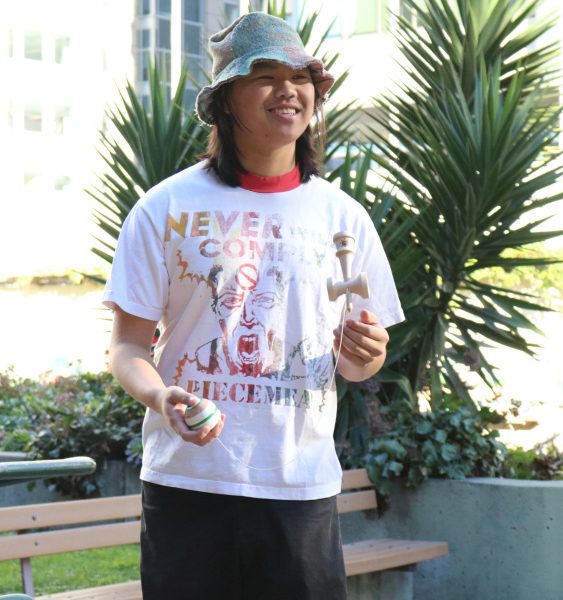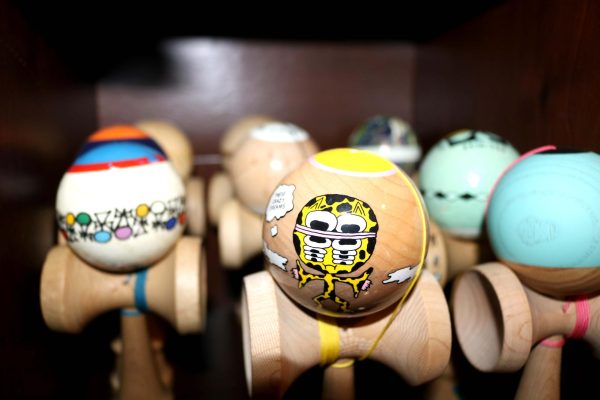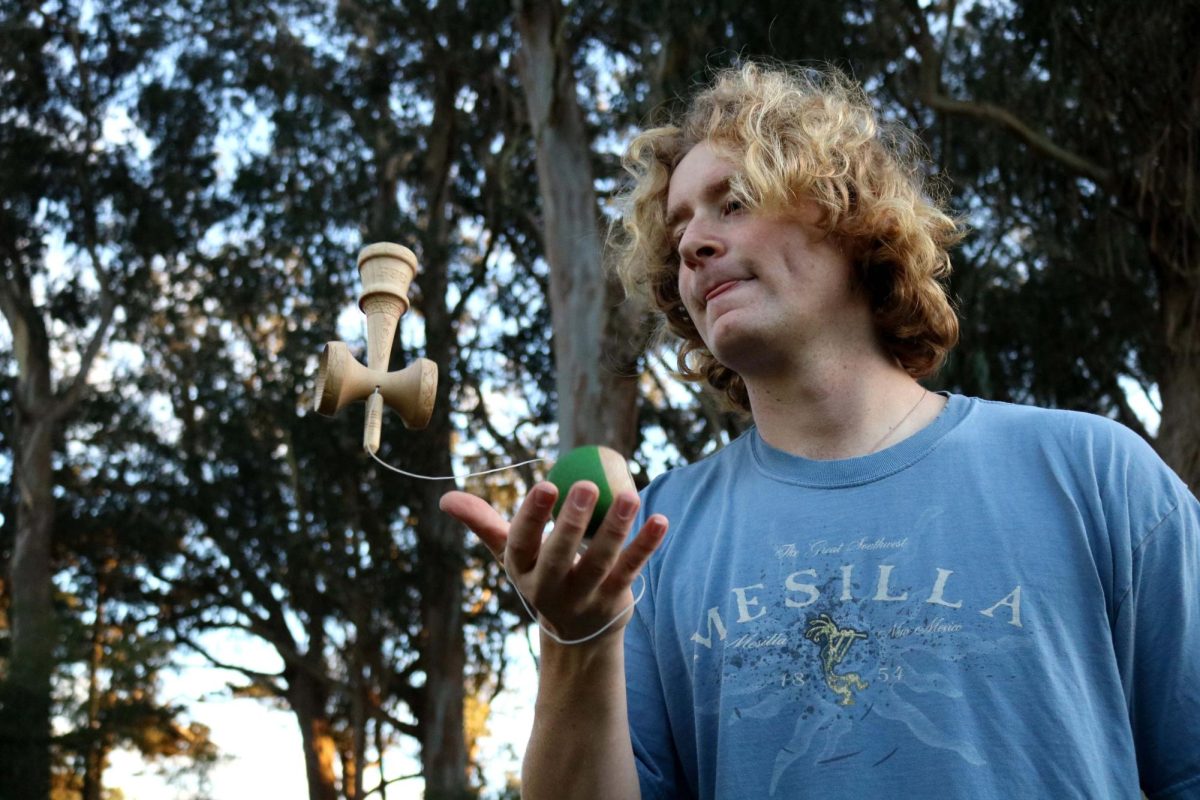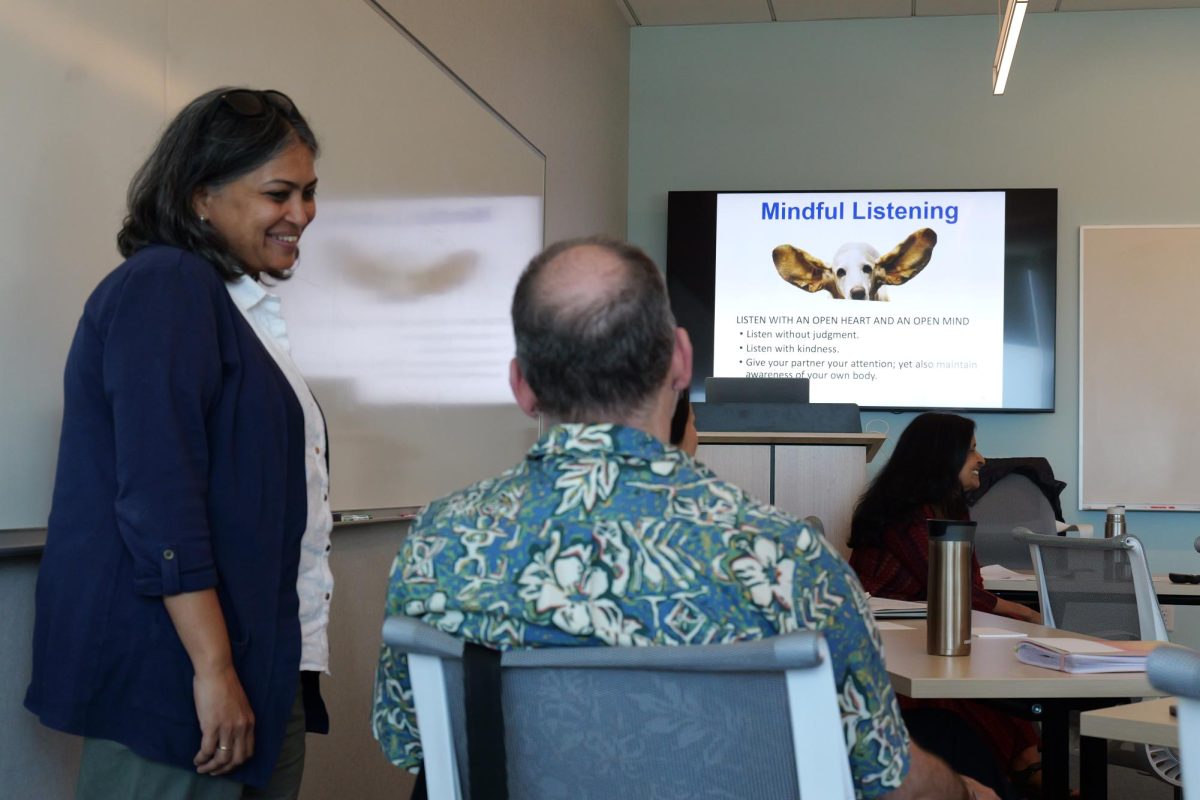Those who were in school between 2012 to 2014 or so have probably seen someone playing with a kendama at some point. They might have even asked them to try it out and swung it around, replicating their tricks and spearing the ball on the tip of the trident-esque wooden handle or catching it on the cups on either side.
Although many people have at least seen someone playing with a kendama, fewer seriously adopt it as a hobby. Over the last few years, kendamas have become more and more popular due to the satisfying sense of trial, error and reward they provide to players, as well as being accessible to just about anyone, anywhere.
“You can do it anywhere,” said A.J. Moyer, founder of Southern California-based company Quad Kendamas. “A lot of YouTube channels had their subscribers and views go up during COVID. People are at home and it makes time pass and it’s just something to work on. If you had a full day to just sit around, it’s a boredom killer.”
The first ball-and-cup toys were from as early as the 16th century, found in places like France and China, but the modern kendama shape that’s known today originated in Hatsukaichi, Japan, in 1921, where it was first mass-produced in factories that traditionally produced wooden dolls and furniture. For approximately the next 80 years, kendama was a skill toy that was primarily enjoyed in Japan. Until companies like Kendama USA popped up in 2008, it was difficult to even obtain a kendama outside of Japan.
Jeremy Stephenson, founder of Kendama USA, was on a skateboarding tour in Japan in the summer of 2006, taking a bus from one skate spot to another, when a friend pulled a kendama out of his bag and started playing with it to pass the time. Beyond being a good time killer on long bus rides, Stephenson noticed and appreciated the similar sense of challenge and reward between kendama play and skateboarding. Picking up a kendama even helped break down some language barriers with non-English speaking locals on his trip.
“I’d be meeting new people all the time and being in hostels, for example,” Stephenson said. “Even if I couldn’t speak the language, you could pick up this game and have a whole conversation basically just through [kendama]. You can teach someone how to play without knowing their language.”
Returning from Japan with a new hobby that he was eager to spread back home, Stephenson created a blog: Kendama USA, a website where players could upload videos of themselves hitting tricks and talk to like-minded enthusiasts. At its origin, it was akin to a video-hosting message board. Today, it’s one of the most popular kendama retailers in the country, with hundreds of models to choose from. A Google search for nothing more than the word “kendama” will spit out Kendama USA’s shop as the first search result.
The shift from community blog to dominating retailer happened organically, as people who saw the videos and became interested in trying kendama for themselves didn’t have anywhere to get them, short of making a trip to Japan. Stephenson originally had a friend in Japan mail him a box of several kendamas to distribute to interested friends, but soon realized he couldn’t just ask just one guy to act as the middleman between Japan and every American who wanted a kendama. After requests from friends asking to purchase a kendama turned to friends of friends of friends asking, Stephenson figured he had to set up something more cohesive.
“I knew I couldn’t ask my friend to drive back to the store and ship stuff across the world, so I asked him if there was anywhere that we can get it in bulk or if he knew any suppliers,” Stephenson said. “That’s kind of what originally started it; I was just trying to get it into other people’s hands because everyone who saw one would eventually ask, ‘Where do I get one?’ And there just wasn’t a good spot for it.”
This period of the late 2000s and early 2010s marked the origin of competitions such as the Kendama World Cup, the North American Kendama Open and Kendama USA’s Dama Open, which spurred more and more people to pick up kendamas.

Vincent Ho is a born-and-raised San Franciscan who was first introduced to kendama during kendama’s first American boom. He was 13 years old at a tutoring center when one of the tutors came in with a kendama and showed him how to play. This experience, as well as watching kendama videos on YouTube, spurred Ho to go to Japantown and purchase one of his own. San Francisco’s presence in popular kendama videos of that early 2010s era was part of the appeal to Ho.
“I feel like the reason kendama lured me in was because in the kendama videos back then, there were some that were shot in San Francisco and I felt like it was a local thing,” Ho said. “I was like, ‘Oh shit, there’s people in San Francisco that do this too,’ and that lured me in.”
Ever since then, Ho has been consistently playing, practicing, and improving his kendama skills. Like many, he was introduced to the game in middle school. As is the case with lots of middle school trends, people will eventually forget about it and give it up. The COVID-19 lockdowns provided many ex-kendama players with the perfect opportunity to rekindle their old hobbies.
“There’s just a bunch of people that got bored inside. They’re like, ‘Man, what am I gonna do with the rest of my time indoors and not be on a cellular device on my phone or my computer or some shit like that?’” Ho said.
Tobias Roat, an SF State alum, is one such individual who first picked up a kendama on his middle school campus in 2013. But it wasn’t until the lockdowns of 2020 that he seriously picked it up as a hobby.
“Some people maybe really did like it but thought it was not cool, so then they stopped playing it,” Roat said. “I think I kind of stopped playing for a little bit after middle school because I didn’t want to be seen playing with a kendama, but I realized that doesn’t matter.”
Seven years after he first picked it up, Roat found himself back at home during the COVID-19 lockdowns, sitting in his sister’s childhood bedroom when he saw a kendama lying around.
“I was like, ‘Oh, I remember this,’ and then I was like, there’s this trick I always wanted to get. It’s called a Whirlwind,” Roat said.
And thus began the quest for the elusive Whirlwind. Two days and hundreds of failed attempts later, he finally caught one on video.
“It feels amazing; the reward is so good because it’s not only physical, it’s mental,” said Roat. “The ‘practice makes perfect’ saying, that’s a classic. We can all say it, but I really discovered the true meaning of that with this toy.”
Despite the thrill he felt when he finally executed the whirlwind for the first time, Roat now considers it to be a relatively basic trick. It could be compared to a kickflip in skateboarding — a basic trick that can be built upon to perform more complicated maneuvers.
The delayed gratification of working on a trick for hours and hours until a combination of chance and skill smiles upon a player and allows all the pieces to fall into the right place is one of the main draws for many players. However, the improved hand-eye coordination that can come from honing one’s kendama skills can translate directly into other, more practical aspects of life. Roat played on SF State’s volleyball team before his graduation in Spring 2023, and noticed his game improved after getting back into playing kendama.

“I took a break from volleyball during that COVID[-19] time and I was playing kendama for like a year and a half, and then I came back to volleyball and for some reason, I was so good at passing the ball. I think it seemed like it was slower or something, I could just see where the ball is going, or just know. So it definitely heightened my coordination,” Roat said.
For those that aren’t athletes on the side and have no concern with being able to predict a passed ball’s trajectory, don’t think that kendama can’t still be useful to other aspects of daily life. Devin Incillo, a local kendama player, noticed sharpened reflexes in a variety of ways.
“[It’s] the little things: something’s falling off the counter, or I’m playing with my dog and she’s trying to grab something from me — little reflexes like that,” Incillo said. “You start to notice that you start to slow down a little bit and you kind of focus in that moment.”
Beyond the improved hand-eye coordination, the perseverance and determination that’s required to attempt a trick hundreds of times to get it just right can also be applied to more practical aspects of life.
“I think it’s the same type of motivation you can put in life if you wanna do something. You know, it could be something as simple as picking up a kendama and landing a trick or something more extreme like starting your own business,” Incillo said.
One of the draws of kendama is the freedom to play quite literally anywhere that has a couple of feet of space, but gathering with fellow kendama players and doing tricks together can provide a sense of community and encouragement among players.
This past April, Roat was walking near Dolores Park when a person driving past rolled down their car window and shouted “Do a whirlwind!” Roat happily obliged his request, and the driver revealed his kendama and matched Roat’s trick while still in traffic. Since then, both of them, as well as a handful of other local players including Incillo and Ho, have made an effort to host at least weekly meetups around the city where they’ll all practice tricks and cheer each other on. [29] Some of their favorite gathering spots are St. Mary’s Square near Chinatown, the Yerba Buena Gardens and the steps of City Hall.
“Playing with other people makes it a whole different game. You see what they’re doing and you’re like, ‘Oh, wait, I wanna try that,’ or, ‘Oh, I’ve never seen that kind of move,’ […] it progresses you and improves your skill because it makes you want to play better if you see other people playing good.” Roat said. “You can also play games with other people, there’s ‘K.E.N.,’ like “H.O.R.S.E.” in basketball or a game called “Follow” where you do the same trick and keep building up on the trick.”
For this group of local players, the community and the satisfaction from landing difficult tricks that kendama provides is enough. However, there are professional kendama players. Companies will build a team of players and sponsor them, providing them with kendamas and even airfare and hotel accommodation to compete in various tournaments and contests. Arguably, the pinnacle of these competitions is the Kendama World Cup, hosted in Hatsukaichi, Japan, which has doled out up to $5,000 to its top scorers in past years.
In June 2023, Moyer organized and held the first California Kendama Cup at the Adams Avenue Theatre in San Diego.
“It was one full day of competition. We had a jam the day before and the day after, and we had all divisions from beginner, intermediate, advanced and then we had amateur, pro and freestyle,” Moyer said. “We had people flying in for the event; we had a lot of vendors and support from the community and cash prizes to the podium winners. It was great.”
Although Quad Kendama is a relatively young company, having only been founded two years ago, they’ve already sold over 1,000 kendamas and hosted a large local competition, demonstrating the rapid growth of kendama in California.
Winners of competitions receive cash prizes and glory. Still, the industry isn’t large enough to sustain a population of professional players who make a living off kendama in the same way that professional surfers or skateboarders do. Anyone who reaches the top percentile of their chosen field is going to be passionate about what they do, but top-level kendama players truly have to be doing it out of a pure love of the game. As interest in kendama grows, Moyer hopes that the industry will be able to provide more opportunities to players that allow them to focus on kendama.
“There’s not a lot of money in kendama because it is still sort of a niche sport. As a company owner, I do my best to support my players,” Moyer said. “I would hope that as the sport grows more money comes in and more companies can support their players, and have more of an incentive for players to be professional.”
The world of professional kendama competitions is not for the fainthearted. For the rest, simply killing some time at the train station or cheering on a friend who just landed their first whirlwind is enough.
“The competition guys aren’t necessarily different from any of us, but they’re just like, honed. They’re just so good at kendama,” Roat said. “I’m not expecting to be like the best in the world but it’s fun to just play and get better, you know.”
Players don’t even have to dedicate hours every day to mastering the craft, the sense of accomplishment that a beginner gets when they land the most basic tricks is still enough to be satisfying.
“I just say just give it a try,” Moyer said. “If you see somebody playing, go up to them and ask them what it is and even ask to try, and 100% of the time, they’re gonna be excited to show you and teach you.”






















